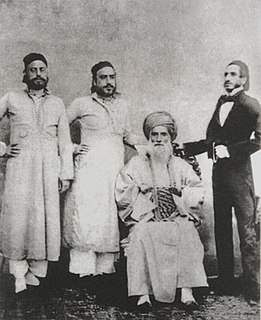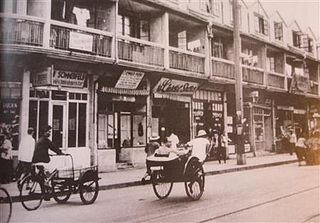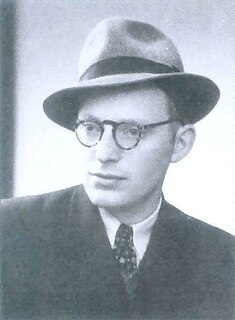
Rabbi Aharon Kotler (1891–1962) was an Orthodox Jewish rabbi and a prominent leader of Orthodox Judaism in Lithuania, and later the United States, where he founded Beth Medrash Govoha in Lakewood Township, New Jersey.
Jews and Judaism in China are predominantly composed of Sephardi Jews and their descendants. Other Jewish ethnic divisions are also represented, including Ashkenazi Jews, Mizrahi Jews and a number of converts.

The former communities of Jewish migrants and their descendants from Baghdad and elsewhere in the Middle East are traditionally called Baghdadi Jews or Indo-Iraqi Jews. They settled primarily in the ports and along the trade routes around the Indian Ocean and the South China Sea.
Recorded Jewish history in the Philippines started during the Spanish period.

Chaim Leib Halevi Shmuelevitz, — also spelled Shmulevitz, in Hebrew: חיים שמואלביץ — was a member of the faculty of the Mirrer Yeshiva for more than 40 years, in Poland, Shanghai and Jerusalem, serving as Rosh yeshiva during its sojourn in Shanghai from 1941 to 1947, and again in the Mirrer Yeshiva in Jerusalem from 1965 to 1979. He taught, guided, and inspired thousands of disciples throughout his lifetime, by word and deed, with legendary diligence and intensity in Torah study.

The Shanghai Ghetto, formally known as the Restricted Sector for Stateless Refugees, was an area of approximately one square mile in the Hongkew district of Japanese-occupied Shanghai. The area included the community around the Ohel Moshe Synagogue. About 23,000 of the city's Jewish refugees were restricted or relocated to the Shanghai Ghetto from 1941 to 1945 by the Proclamation Concerning Restriction of Residence and Business of Stateless Refugees. It was one of the poorest and most crowded areas of the city. Local Jewish families and American Jewish charities aided them with shelter, food, and clothing. The Japanese authorities increasingly stepped up restrictions, was surrounded by barbed wire, and the local Chinese residents, whose living conditions were often as bad, did not leave.

Yosef Chaim Shneur Kotler was an Orthodox rabbi and rosh yeshiva of Beth Medrash Govoha in Lakewood, New Jersey from 1962 to 1982. During his tenure, he developed the Lithuanian-style, Haredi but non-Hasidic yeshiva into the largest post-graduate Torah institution in the world. He also established Lakewood-style kollels in 30 cities, and pioneered the establishment of community kollels in which Torah scholars study during the morning and afternoon hours and engage in community outreach during the evenings. Upon his death, he had served as the Lakewood rosh yeshiva for exactly the same amount of time as had his father, Rabbi Aharon Kotler, the founding rosh yeshiva of Beth Medrash Govoha: nineteen years, seven months, and one day.

The Mir Yeshiva, known also as The Mir, is an Orthodox Jewish yeshiva in Beit Yisrael, Jerusalem. With over 8,500 single and married students, it is the largest yeshiva in the world. Most students are from the United States and Israel, with many from other parts of the world such as UK, Belgium, France, Mexico, Switzerland, Argentina, Australia, Russia, and Canada.

The Mirrer Yeshiva Central Institute, commonly known as the Mir Yeshiva or the Mirrer Yeshiva, is a prominent, Haredi yeshiva located in Brooklyn, New York known for talmudic studies.

The Mir Yeshiva, commonly known as the Mirrer Yeshiva or The Mir, was a Lithuanian yeshiva located in the town of Mir, Russian Empire. After relocating a number of times during World War II, it has evolved into three yeshivas, one in Jerusalem, with a subsidiary campus in Brachfeld, Modi'in Illit, and the other two in Brooklyn, New York: the Mir Yeshiva, and Bais Hatalmud.
Jews have been present in Hong Kong since the mid-19th century. As a major financial centre, much of Hong Kong's Jewish community is temporary in nature, largely consisting of expatriates from countries with much larger Jewish populations, such as Israel, United States, France, and other countries.
The history of the Jews in Kobe, Japan, is recorded from the 19th century onwards.

Silas Aaron Hardoon was a wealthy businessman and well-known public figure in the city of Shanghai in the early 20th century.
Erlau, is a Haredi dynasty of Hungarian origin, which follows the teachings of the Chasam Sofer and is often considered Hasidic.

Avraham Kalmanowitz was an Orthodox rabbi and rosh yeshiva of the Mir yeshiva in Brooklyn, New York from 1946 to 1964. Born in Belarus, he served as Rav of several Eastern European Jewish communities and escaped to the United States in 1940 following the German occupation of Poland. In the U.S. he became a tireless rescue activist on behalf of the millions of Jews trapped in Nazi Europe and in the Soviet Union. He is credited with the successful transfer of the entire Mir yeshiva from Lithuania to Shanghai, providing for its support for five years, and obtaining visas and travel fare to bring all 250 students and faculty to America after World War II. He established the U.S. branch of the Mir in 1946. In the 1950s he aided North African and Syrian Jewish youth suffering from persecution and pogroms, and successfully lobbied for the passage of a bill granting "endangered refugee status" to Jewish emigrants from Arab lands.

The Shanghai Exhibition Center or the Shanghai Exhibition Hall is an exhibition and convention center in central Shanghai. The building was built in 1955 as the Sino-Soviet Friendship Building to commemorate the alliance between China and the Soviet Union, a name by which many locals still refer to the building. Reflecting its original name, the design draws heavily on Russian and Empire style neoclassical architecture with Stalinist neoclassical innovations.

The Shanghai Jewish Refugees Museum is a museum commemorating the Jewish refugees who lived in Shanghai during World War II after fleeing Europe to escape the Holocaust. It is located at the former Ohel Moshe or Moishe Synagogue, in the Tilanqiao Historic Area of Hongkou district, Shanghai, China. The museum features documents, photographs, films, and personal items documenting the lives of some of the more than 20,000 Jewish residents of the Restricted Sector for Stateless Refugees, better known as the Shanghai Ghetto, during the Japanese occupation of Shanghai.

The Ohel Rachel Synagogue is a Sephardi synagogue in Shanghai, China. Built by Sir Jacob Elias Sassoon in memory of his wife Rachel, it was completed in 1920 and consecrated in 1921. Ohel Rachel is the largest synagogue in the Far East, and one of the only two still standing in Shanghai. Repurposed first under the Japanese occupation during World War II and again following the Communist conquest of Shanghai in 1949, the synagogue has been a protected architectural landmark of the city since 1994. It was reopened for some Jewish holidays from 1999 and briefly held more regular Shabbat services as part of the 2010 Shanghai Expo.

Rabbi Meir Ashkenazi was a Chabad rabbi who served as chief Rabbi of Shanghai from 1926-1949.
















